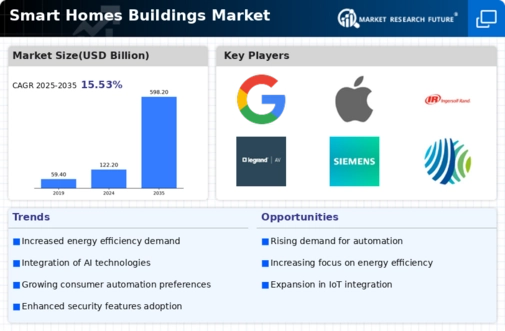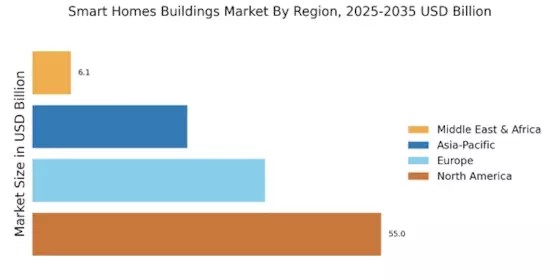Advancements in Smart Technology
Technological advancements play a pivotal role in shaping the Smart Homes Buildings Market. Innovations in artificial intelligence, machine learning, and the Internet of Things (IoT) are revolutionizing how homes operate. For instance, smart thermostats can learn user preferences and adjust heating and cooling accordingly, leading to energy savings of up to 30%. Furthermore, the integration of voice-activated assistants has made controlling home systems more intuitive. As technology continues to evolve, the capabilities of smart home devices expand, offering enhanced functionalities that appeal to consumers. This continuous innovation fosters a competitive landscape, encouraging manufacturers to develop cutting-edge solutions that meet the growing expectations of homeowners. Consequently, the Smart Homes Buildings Market is likely to witness sustained growth driven by these technological advancements.
Growing Awareness of Home Security
The heightened awareness of home security concerns is a significant driver for the Smart Homes Buildings Market. With rising crime rates in various regions, homeowners are increasingly prioritizing security measures. Smart security systems, including surveillance cameras, motion detectors, and smart locks, offer enhanced protection and peace of mind. Recent surveys indicate that over 60% of homeowners consider security features a top priority when selecting smart home products. This growing emphasis on safety is prompting manufacturers to develop advanced security solutions that integrate seamlessly with other smart home systems. As a result, the Smart Homes Buildings Market is likely to experience robust growth, driven by the demand for comprehensive security solutions that cater to the evolving needs of consumers.
Government Initiatives and Incentives
Government initiatives aimed at promoting energy efficiency and sustainability significantly impact the Smart Homes Buildings Market. Various countries have introduced incentives for homeowners to adopt smart technologies, such as tax rebates and grants for energy-efficient upgrades. For example, programs that encourage the installation of smart meters and energy management systems are gaining traction. These initiatives not only support environmental goals but also enhance the appeal of smart homes to consumers. As governments increasingly recognize the importance of reducing carbon footprints, the demand for smart home solutions is expected to rise. This supportive regulatory environment creates a favorable landscape for the Smart Homes Buildings Market, potentially leading to increased investments and innovations in smart home technologies.
Rising Consumer Demand for Automation
The Smart Homes Buildings Market experiences a notable surge in consumer demand for automation solutions. Homeowners increasingly seek convenience and efficiency, driving the adoption of smart technologies. According to recent data, approximately 70% of consumers express interest in automating their home systems, including lighting, heating, and security. This trend indicates a shift towards integrated home management systems that enhance user experience. As consumers become more tech-savvy, the expectation for seamless connectivity among devices grows. This demand for automation not only simplifies daily tasks but also contributes to energy savings, making smart homes an attractive option for many. The Smart Homes Buildings Market is thus positioned to benefit from this rising consumer inclination towards automated living environments.
Sustainability and Environmental Concerns
Sustainability and environmental consciousness are becoming central themes in the Smart Homes Buildings Market. As awareness of climate change and resource depletion grows, consumers are increasingly seeking eco-friendly solutions for their homes. Smart technologies that optimize energy consumption, such as smart lighting and energy-efficient appliances, are gaining popularity. Data suggests that homes equipped with smart technologies can reduce energy usage by up to 20%. This shift towards sustainable living not only aligns with consumer values but also contributes to long-term cost savings. Manufacturers are responding to this trend by developing products that emphasize sustainability, thereby enhancing their market appeal. Consequently, the Smart Homes Buildings Market is poised for growth as it aligns with the global movement towards environmentally responsible living.

















Leave a Comment